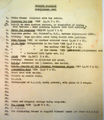Paolozzi
Delia created music for BBC Radio 4's "RadioVision" schools' programme "Paolozzi" produced by Joan Griffiths.[1]
In January 1971, Joan Griffiths wrote to Desmond Briscoe saying that "Eduardo Paolozzi has agreed to take part in devising and broadcasting a radiovision programme on his work, to be broadcast in Autumn 1971, and recorded in April and May, completed at latest by June."[2]
Its tape's catalogue entry is dated March 1971[1] and the booklet accompanying the broadcast is dated Autumn 1971.[3]
The BBC Genome Project lists:[4]
BBC Radio 4 Wednesday 7 March 1973 11.40 Art and Humanities Eduardo Paolozzi (radiovision) script by FRANK WHITFORD Music by DELIA DERBYSHIRE BBC Radiophonic Workshop
Papers
DD131250: Typewritten carbon copy "EDUARDO PAOLOZZI - Preliminary list" with items 1 to 30.
DD131149: Typewritten carbon copy "Paolozzi RV Art and Design, Autumn 1971: List of Frames (near to final order)", first page with items 1 to 22.
- DD105241-DD105751: 19-page booklet "Paolozzi Art and Design: BBC Radiovision Notes, Autumn 1971" of which there is a high-definition scan of the cover in the Medialink library.
Availability
- Broadcast on the 7th March 1973 at 11:40 on BBC Radio 4.[4]
- The BBC Sound Archive's tape TRW 7352 is missing.[1]
- The accompanying booklet "Radiovision Notes", encourages schools to tape record the programme and to show it accompanied by a BBC-produced filmstrip of slides, so it is conceivable that some school or teacher may still have a copy of the audio and/or of the slides.[5]
References
- ↑ 1.0 1.1 1.2 The Tape Library List's entry for TRW 7352.
- ↑ DD130959: Memo dated 25.1.71 from Joan Griffiths to Desmond Briscoe.
- ↑ DD105241-DD105751: 19-page booklet "Paolozzi Art and Design: BBC Radiovision Notes, Autumn 1971."
- ↑ 4.0 4.1 Paolozzi's entry in the BBC Genome Project.
- ↑ BBC Radiovision Notes for Paolozzi, p.2: “How to get the best out of this radiovision programme: The radio part of the programme, including the announcements, should be tape recorded. For best results it should be recorded long anough in advance of its use with a group for the operator to have gone through it beforehand, together with the filmstrip. The filmstrip (which may be cut into slides, if preferred) and the tape together make a complete programme.”


